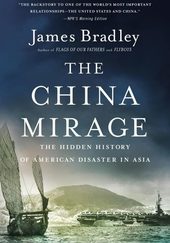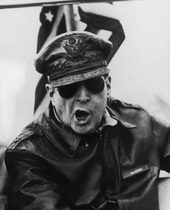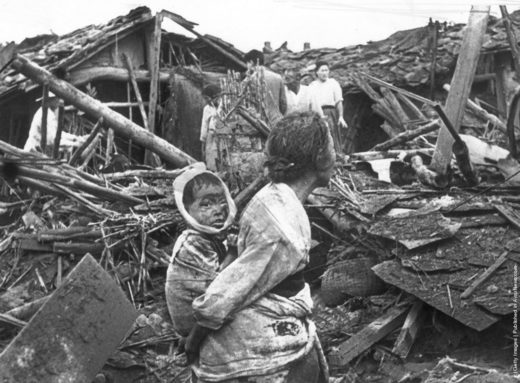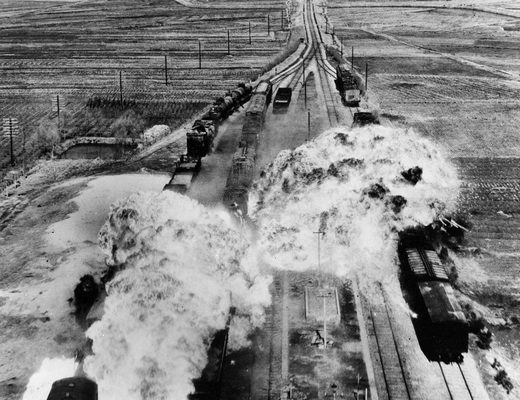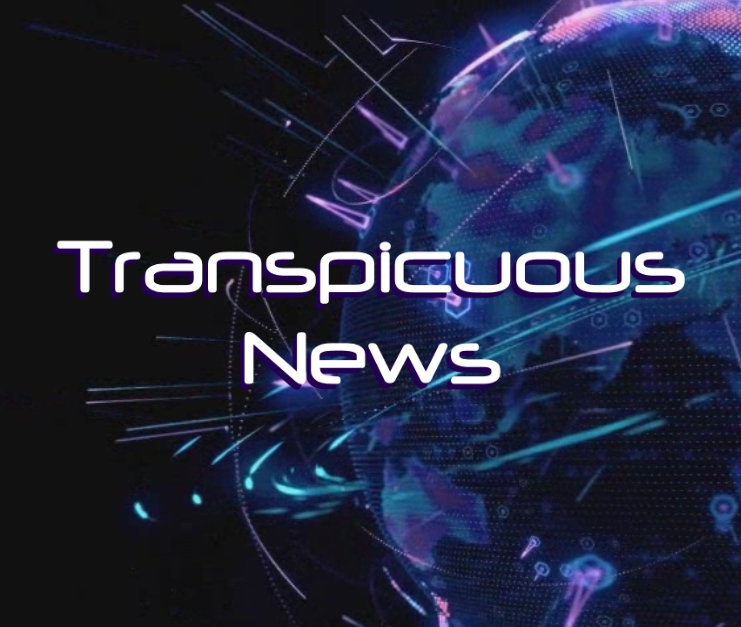 Over the past few years I’ve spoken about the bait and switch game the US and western governments and media have played on the public. There is always a “drama” being played out “somewhere else”.
Over the past few years I’ve spoken about the bait and switch game the US and western governments and media have played on the public. There is always a “drama” being played out “somewhere else”.
“Look at the Ukraine!! Horrible things happening in the Ukraine… no, look at Syria now!! Oh Wait, North Korea!! Actually, look over here at Iran- yes it’s definitely Iran that’s the problem… ” and it’s played on a constantly repeating loop- Syria, Iran, Russia, China, Ukraine, North Korea, over to Iraq, then Libya, and back to Syria… and a quick flash back over to North Korea again.
Right now, the War Machine is rattling the saber at North Korea once again, and trying desperately to drive the public into a fear frenzy that yet another war is coming. One of the best ways to see through all of this bullshit is to take a look at the history of the situation and at the hinted at facts of what is actually going on. These two articles I’ve posted below, are both an excellent jump off point for those who want to do their own research and want to see through the bullshit lies. Both articles are definitely open for discussion and have their own “spin” you could say, but within them are some shining pieces of truth that shed a vastly different light on what’s actually happened/been happening between the US and North Korea.
d
How the US Empire was made in North Korea
Over the past 15 years, fighting-talk has periodically flared over ‘what to do about that crazy Asian dictator’ in North Korea. Today’s round of brinkmanship by the US/Western ‘deep state’ against North Korea will – in all probability – unfold the same way as in previous episodes; it will fizzle out. China is a guarantor of North Korean security, so the US will not go to war with North Korea. Period.
The battle between Trump and the Washington Crazies for control of the reins of empire continues, however, and the ‘Krazy Korean’ is relevant to that. I hope to get to that in a later article, but in the meantime, take note of the contradictory messages coming from the US. One minute, US Navy battle-groups are ‘en route to North Korea’; the next they’re heading in the opposite direction. One minute, THAAD missile systems are ‘installed and operational in South Korea’; the next, Trump wants South Korea to pay for them. One minute, someone on the US National Security Council is telling NBC News that the US is considering ‘decapitating the North Korean regime’; the next, Trump announces he’d be honored to meet Kim Jung Un… All of which has provoked the South Korean and Japanese governments to denounce Trump’s confusing and contradictory statements. Is there a method in Trump’s apparent madness?
I recently read The China Mirage: The Hidden History of American Disaster in Asia by James Bradley, a breathtaking panorama of US and Chinese trajectories from the Opium Wars in the mid-19th century to the birth of ‘Communist’ China and ‘Pax Americana’ a hundred years later. This naturally encompassed US involvement in Korea, so in this article I’d like to share some historical context that is either incomplete or missing from summaries of US-Korean relations I’ve seen online so far.
The US has a long history of propping up crazy Asian dictators – from imperial Japan to ‘Christian’ Chiang Kai-shek in ‘New’ China to Catholic Diem in the short-lived US invention of South Vietnam. ‘North’ Korea is similarly a US invention. After existing for hundreds of years as a sovereign country, Korea fell under Japanese imperial influence in the late 19th century. The Japanese had by then become the ‘Yankees of the Far East’ and so accepting were they of civilized Western ways (and Anglo-Saxon values in particular), that the US and British empires were able to convince the Japanese that they should expand their empire as a check against Russian economic expansion in the Far East and as a vehicle through which to ‘Americanize’ China and the wider region.
In 1882, the US signed a treaty with the Emperor of Korea, declaring that there “shall be perpetual peace between Korea and the US.” If Korea was ever threatened by a third party, the US would intervene on its behalf. In the East, such commitments are both legally and morally binding. Not so in the West, however. Behind Korea’s back, then-US president Theodore Roosevelt (whose family, like all the US patrician families, got rich illegally smuggling opium into China), gave Japan the green light to take over Korea in 1905 (under the fabricated pretext that if they didn’t, the Russians would beat them to it) and use it as a staging ground to launch war on Russia. Bradley recounts this treachery in The China Mirage:
In March of 1905, when wave after wave of Japanese soldiers ran directly into Russian bullets during Japan’s victory at the Battle of Mukden, Roosevelt wrote, “The Japanese are the most dashing fighters in the world!” For the first time in modern history, an Asian country was besting a white Western Christian country. Roosevelt wrote [Baron] Kaneko [Japanese envoy to the US] on White House stationery, “Judging by the state of affairs, all is going well and your army is advancing at full speed and power. Banzai!!” When the baron later arrived at the White House for a celebration of the Mukden victory, Roosevelt’s “face shone with joy over the unprecedented victory.” After his chat with Kaneko, Roosevelt told Secretary of War William Howards Taft, “I heartily agree with the Japanese terms of peace, insofar as they include Japan having the control of Korea.” [p.72]
Korea found few advocates. John ford, the secretary of the American Asiatic Association, a major trade group, defended Japan’s takeover of Korea because “the true peril of Asia and of the world is the Muscovite, and not the yellow peril.”
The ‘yellow peril’ refers to the late 19th century realization in Anglo-American power circles that – sooner or later – the vastly more populous East Asia would industrialize and eclipse their Western-led global domination. And yet, it wasn’t that which frightened them most – it was imperial Russia, a fear that echoes down to the present time.
Thus began Korea’s descent into hell, and Japan’s imperial march across the region. Only later would the US have a problem with this; at the time, Japan was being encouraged to apply a ‘Japanese Monroe Doctrine for Asia’ by Roosevelt – a doctrine that was guaranteed – financially, militarily and politically – by the Anglo-Americans. The Japanese occupied Korea, Nazi-style, for the next 45 years, during which time they also invaded and occupied Manchuria, northeast China, in 1931. They then spread further southwards into China in 1937, slaughtering millions of people as they went (35 million, according to Chinese sources).
By the time WW2 broke out, the Japanese war machine was heavily reliant on Californian oil, which then-US president Franklin Roosevelt (cousin of the first Roosevelt) was loathe to choke off for fear the Japanese would declare war against the US at a time when it was focused on the situation in Europe. To hedge its bets, imperial Japan spread further south into Indochina and Indonesia to take over oil fields and other raw materials.
And that’s where it crossed the Anglo-Americans’ red line: the Japanese were eyeing up key resources in Western colonies. In a move they knew would collar Japan’s regional ambitions, and thus likely be interpreted by the Japanese as a declaration of war, the so-called ‘wise men’ around Roosevelt (who we might today recognize as actors of the ‘deep state’) went behind his back to embargo oil shipments to Japan, which hadn’t yet secured much-needed resources in South-East Asia, triggering its decision to attack the US Pacific Fleet at Pearl Harbor in Hawaii. There is some debate as to whether or not Japan’s surprise Pearl Harbor really surprised the Americans, but in any event, history records that once the US military entered the west Pacific, it planned to stay there.
While the rest of the world celebrated the end of the second ‘war to end all wars’, US elites watched aghast as ‘dirty commie’ Mao Zedong took control of all China by 1949, forcing their crazy Asian dictator (the actual Chinese one, Chiang Kai-shek) to flee to Taiwan, which the US then recognized as ‘the real China’.
This brings us to the second US ‘sell-out’ of Korea. After the US invited the USSR to defeat the remnants of the Japanese military in N.E. China on its behalf (‘better their boys do the fighting than ours’), the Soviets pushed the Japanese into the Korean peninsula, but only as far south as 38 degrees north, an arbitrary line drawn by the US that split Korea in two. As Bradley points out, “no one in the US thought to consult the Korean people about this division of their ancient land.”
‘Wise Man’, by the way, is a moniker for the handful of US strategists at the State Department and elsewhere who did most to chart American foreign (really, imperial) policy during and after WW2. These are the ‘geniuses’ who came up with the plans to ‘contain’ the USSR away from western Europe, and likewise China from its neighbors by re-instituting Japan as the region’s dominant power. Bradley continues:
Koreans were even more outraged to learn that US officials would govern South Korea with help from the Koreans’ former Japanese colonial masters. North Koreans watched uneasily as South Koreans who had cooperated with the Japanese occupation now helped the US gain influence on the Korean Peninsula. Koreans had just suffered 40 years of Nazi-like domination by the Japanese. North Korean leader Kim Il Sung had begun his military career fighting the Japanese in the spring of 1932, and his government was first of all, and above all else, anti-Japanese.
A major concern of Dean Acheson’s [then US Secretary of State] was reinvigorating the world economy after the devastation of WW2. In Europe, the US would adopt a program of economic aid called the Marshall Plan; in Asia it was known as Policy for Asia, National Security Council document 48/2. According to NSC-48/2, Japan would become Asia’s industrial economy, fired by US companies. Washington would ‘connect up’ other Asian economies to Japan’s industrial machine and as markets for Japanese goods (thus isolating and containing China). […] Their plan called for Korea, Vietnam, and other Asian countries to be the supply/consumption machines within the US-Japanese orbit. The American military would provide an umbrella of security for Japan and keep the other Asian countries in line.
The Wise Men didn’t understand that their Policy for Asia looked to many Asians alarmingly like imperial Japan’s recent attempts at empire. To them, it was as if the US was green-lighting another era of Japanese dominance with American backing. When North Korean leaders realized that Washington wanted Japan to once again dominate Korea, they perceived a mortal threat. […]
A good friend of English economist John Maynard Keynes, Acheson wondered if a huge Keynesian expansion of US military spending could prime the worldwide pump.
Acheson’s top secret policy was laid out in National Security Council document 68, which called for something new in American history: an enormous US military encircling the globe to protect ‘war-making capabilities’ of its allies, a euphemism referring to countries with resources that American industry needed to manufacture arms to contain Communism worldwide. […]
Acheson urged Truman not only to go to war in Korea with no congressional consultation, but also to send covert military aid to the French in Indochina for their war against Ho Chi Minh. With no debate – and none was sought – a Wise Man, rattled by events in Asia he little understood, committed the US to current and future wars. [p.344]
One of the great ironies of this set-up to ‘contain China’ is that Mao wanted his country to be included in US post-WW2 development plans; he wanted US industry and capital to develop China, something that wouldn’t begin until Henry Kissinger ‘saw the light’ in 1972.
Kim Il Sung realized that the reanimation of his arch enemy (Japan) meant that the imaginary war-time line would become a permanent hard border. It’s well-known that North Korean troops invaded (liberated from Japanese collaborators, in their view) the South, sparking the Korean War of 1950-1953. Left out of the narrative is the nature of the ‘good guys’ that the US rushed to defend. Australian human rights lawyer James O’Neil writes:
The US felt able to leave South Korea in 1948 because they had installed the US-educated Syngman Rhee as dictator. He ruled as dictators do, killing, jailing or driving into exile tens of thousands of his political opponents. Rhee was finally overthrown in a popular revolution in 1960. In scenes later to be replicated in Saigon in 1975, he was plucked from his palace by a CIA helicopter who ferried him to safety while the crowds converged on the palace.
Rhee also had ambitions to forcefully bring about the reunification of the two parts of Korea. Thanks to the scholarship revealed in Professor Bruce Cumings’ two volume history of the Korean War we now know that the standard Western line about the Korean War starting with an invasion of the South by troops from the North is at best an approximation of the true history of the conflict. The truth is considerably more complicated.
For years preceding the Northern troops crossing the border in July 1950, Rhee had been staging incursions into the north, carrying out killings, sabotage and other forms of asymmetrical warfare. On the island of Cheju-do for example, as many as 60,000 people were murdered by Rhee’s military forces.
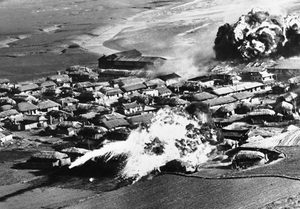
“Hit anything that moves,” US pilots were told. Here, thatched huts go up in flames after B-26 bombers unload napalm bombs on a village near Hanchon, North Korea, on May 10, 1951
Reflecting the ‘game theory’ paranoia of the time, the US elite misread the North’s invasion as a plot hatched in Moscow and Beijing to ‘test’ America’s new global strategy and ‘break out of containment’. Acheson was sure it was a ruse to distract from an imminent invasion of western Europe by Stalin. It wasn’t. It was just the Koreans wanting their country whole again – and foreigners’ influence gone from their peninsula.
In the summer of 1950, the North Koreans quickly overran nearly all of the South. The US raised a hue and cry, organized its first ‘UN coalition of the willing’, and countered with a combined force of over 1.7 million troops to defend the brutal regime of Syngman Rhee. They just as quickly pushed the North Koreans all the way back up the peninsula, past the 38th parallel, and approached the Chinese border. Despite being exhausted by decades of civil war and fighting the Japanese, 2 million Chinese troops – with a relatively small air force and no nuclear weapons – entered North Korea and pushed General Douglas MacArthur’s troops out of North Korea, returning the status quo of the north-south divide by 1951.
O’Neill explains what this first ‘war against communism’ did to North Korea:
What is scarcely acknowledged in the West was the devastation the Korean War wrought upon the North. The US-led UN Command dropped more bombs on the North than the US had dropped in the whole Pacific theatre in World War 2. This included the dropping of 20,000 tonnes of napalm, a particularly gruesome way of killing people. This method was later used to equally horrific effect in Vietnam.
We now also know that the US waged bacteriological warfare, building upon Japanese expertise garnered in their war on China and further developed by US scientists at Fort Detrick.
An estimated two million people, or 20% of the total population, were killed.The bombing flattened every city in the country. In addition, the bombing targeted irrigation dams on the Yalu River. The intention was to destroy the rice crop and thereby starve the population into submission. Only emergency assistance from, among others, the Soviet Union and China prevented widespread famine and death.
All 78 North Korean cities were leveled, along with thousands of villages. The US quite literally wiped ‘North Korea’ from the face of the Earth. Another estimate puts the loss of North Korean lives at one third of the population – so, about 3 million dead. So the Korean War was hell for Koreans, but for the US deep state, North Korea’s invasion of South Korea ‘confirmed’ to them that their policy of containing China was correct, and was the catalyst for transforming the US into a global empire. The Wise Men had powerful incentives to read the situation their way: if this was a global Communist plot to ‘break out of containment’, then both containment theory and practice were correct, justifying the reconfiguration of US military and industry to a permanent, global war-footing. Bradley continues:
The irrational fear of worldwide communism as a result of the Wise Men’s misunderstanding of a small Asian civil war persuaded Congress to dramatically increase funding for the military. Martin Walker wrote,
The first defense budget presented by President Truman after the war began was for $50 billion, the precise figure Acheson had hoped for. The US Army doubled, to over 3 million men. The number of Air Groups doubled to 95, and were deployed to new bases in Britain, Libya, Morocco and Saudi Arabia. Everything changed with Korea. American diplomacy, defense budgets and military reach exploded across the globe.
Bruce Cummings concludes,
The Korean War was the crisis that finally got the Japanese and West German economies growing strongly, and vastly stimulated the US economy. American defense industries hardly knew that Kim Il Sung would come along and save them either, but he inadvertently rescued a bunch of big-ticket projects. […]
The Korean conflict would transform the US into a very different country than it had ever been before: one with hundreds of permanent military bases abroad, a large standing army and a permanent national security state at home.
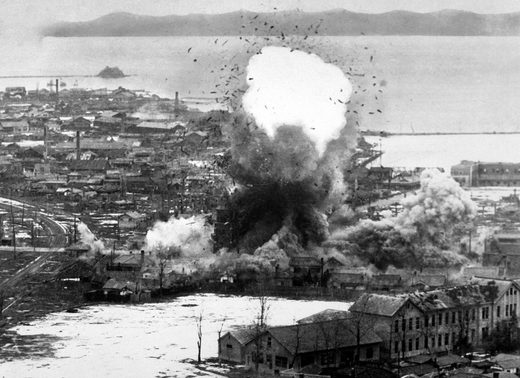
US Air Force bombers destroy warehouses and dock facilities in Wonsan, North Korea, 1951.
Now we understand why North Korea distrusts the US so much. The message behind its apparent belligerence is simply: ‘Stay Away!’
Continue reading on Sott.net HERE: https://www.sott.net/article/350202-How-the-US-Empire-was-made-in-North-Korea
North Korea is an Pentagon Vassal State1
By F. William engdahl
1 November 2016
If it weren’t for the fact that he is absolute dictator of a country with a formidable army and nuclear missile technology, North Korean President Kim Jong Un, the 290 pound, 32 year-old ruler would be a clown figure. Unfortunately for world peace, Kim Jong Un, while he is playing games with his rockets and threats of war, is serving the long-term interests of the USA, especially the military industrial complex, the Pentagon and State Department, whose priority increasingly is to make an Asia Pivot of military power projection to contain and isolate the Peoples’ Republic of China as well as Russia
In the end of the 1990’s I had the chance occasion to have a chat with the late James R. Lilley. Lilley was at the Davos World Economic Forum and by chance had sat at my dinner table together with a delegation from the China Peoples’ Liberation Army. As I was the only westerner at the table he struck up a conversation, and as he saw I was more than conversant in global politics, he began talking, perhaps more than he should have with one he did not know.
James R. Lilley was no outsider. A member, together with his close friend, George H.W. Bush, of the infamous Yale University Skull & Bones secret society, Lilley served some three decades at the CIA along with Bush. Both Lilley and Bush were US Ambassadors to China.
Lilley’s term in Beijing coincided with the May-June 1989 Tiananmen Square student protests. I have reason to believe he played the key US role in orchestrating that clash between thousands of protesting students and the Chinese government as one of Washington’s early Color Revolution attempts to destabilize communist China simultaneously with the CIA’s role in destabilizing the Soviet Union.
At the time of Tiananmen protests, the man who developed the handbook for color revolutions, Gene Sharp, of the Albert Einstein Institute, was in Beijing until the Chinese told him to leave, and George Soros’ Chinese NGO, the Fund for the Reform and Opening of China, after Tiananmen, was banned when Chinese security services found that the fund had links to the CIA.
This background is important to better situate who Lilley was – a consummate insider of the George Bush CIA “deep state” networks that try to remake the world to their liking. In our Davos talk, Lilley told me he had been furious at President G.H.W. Bush in the aftermath of Tiananmen for refusing to make a stronger denunciation of the Beijing government, that, for a massacre that he knew never took place.
In the event, in our Davos discussion we touched on events in Asia and the ongoing focus by Washington on North Korea’s nuclear program. Unexpectedly, Lilley made a remarkable statement to me. He said, “Simply put, at the end of the Cold War, if North Korea didn’t exist we would have to create it as an excuse to keep the Seventh Fleet in the region.1” Shortly before our Davos discussion North Korea had launched a missile over Japan, causing huge anxieties across Asia.
What is Kim Jong Un?
Who or better said, what is Kim Jong Un? Since the death of his father in 2011 Kim Jong Un has consolidated power as absolute dictator. In December 2011 Kim became Supreme Commander of the Korean People’s Army. His earlier history has been carefully hidden. It has been verified that he attended school in Europe at Liebefeld Steinhölzli school in Köniz near Bern. Accounts say he lived in Switzerland, under a false name, from 1991 until 2000. There he reportedly developed a prodigious taste for French Bordeaux wines, Yves St Laurent cigarettes, Swiss Emmenthaler cheese and luxury Mercedes autos according to Kim Jong-il’s former personal chef, Kenji Fujimoto.
While Kim’s extensive stay in Europe might or might not have been the opportunity for US intelligence to nurture some kind of contact, Kim’s deeds since taking control have been a godsend to the US role in disrupting Chinese as well as Russian relations with both North Korea and with South Korea as well as with Japan.
One of Kim Jong Un’s earliest indications of a major shift in foreign policy away from Beijing came when he ordered the arrest of his uncle for treason in December, 2013. Jang Sung-taek had been vice-chairman of the National Defence Commission, second only to that of the Supreme Leader and was “key policy adviser” to the politically inexperienced Kim Jong-un on the death of Kim’s father. More importantly, Jang was well-known as China’s best friend in Pyongyang.
As Washington moved to implement its new Asia Pivot military encirclement policies against China, removal of Beijing’s most influential friend in North Korea would be very convenient, to put it mildly.
Kim Jong Un not only had Jang executed, Jang’s wife, Kim Kyong-hui, the only daughter of former North Korean supreme leader Kim Il-sung, the only sister of former North Korean supreme leader Kim Jong-il and the aunt of Kim Jong-un, a General in the army and Politburo member, was reportedly poisoned on orders of Kim, though no confirmation has been possible. What is known is that Kim ordered the systematic execution of all other members of Jang’s family including children and grandchildren of all close relatives. Those reportedly killed in Kim’s purge include Jang’s sister Jang Kye-sun, her husband and ambassador to Cuba, Jon Yong-jin, and Jang’s nephew and ambassador to Malaysia, Jang Yong-chol as well as the nephew’s two sons. At the time of Jang’s removal, the Kim regime announced, “the discovery and purge of the Jang group…made our party and revolutionary ranks purer …”
Clearly, Kim Jong Un was just the kind of dictator Washington’s warhawks could “do business with.”
Kim’s War Threats
The timing and effect of Kim Jong Un’s bizarre threats to wage war against South Korea and other states of the region, including Japan, as well verbal threats to strike cities on the US West Coast since 2013, fit too neatly into the geopolitical agenda of Washington, but not against North Korea. The agenda of Washington was aimed rather against China and the Russian Far East.
In March 2013, North Korea’s Kim, absurdly enough, threatened the United States with a “pre-emptive nuclear attack”, and Kim Jong-un issued a detailed threat to “wipe out” Baengnyeong Island, under United Nations Command and South Korean control since the Korean War and scene of previous naval clashes. Under Kim Jong Un, North Korea has boasted of plans for conducting nuclear strikes on US cities, including Los Angeles, and Washington, D.C. Military experts suggest the threats were pure macho bravado and that Kim’s nuclear capabilities are bluff at least at this stage. It had the effect of painting Washington as a major enemy of Pyongyang, a useful cover for Washington however and creating the backdrop for Washington to promote its Asian military expansion, in fact aimed at both China and Russia, not Pyongyang.
It’s commonly believed that since the 1950’s Korean War, communist North Korea has been a Beijing puppet regime. It’s true that China is North Korea’s biggest trading partner, and main source of food, arms, and energy. It has also helped sustain Kim Jong-un’s regime, and has historically opposed harsh international sanctions on North Korea. However, the relationship is anything but congenial for Beijing. Their main concern is to keep their North Korea neighbor from exploding in chaos.
While China does maintain certain influence and while China sees North Korea as a buffer between it and the US-allied South Korea, Beijing’s ability to influence the erratic Kim Jong Un seems to be extremely limited, if at all, a significant change from earlier Kim dynasty dictators. The one power to gain from Kim Jong Un’s bellicose actions is the United States as geopolitical hegemon desiring to turn Japan and especially South Korea against China.
In February of this year North Korea announced that it had fired a long-range rocket in violation of a UN Security Council resolution that was voted with approval of both China and Russia. The rocket firing was immediately condemned by Japan, South Korea and the US. Most notably, right after the North Korean rocket firing, the Seoul South Korea government entered serious talks for acquiring Washington’s THAAD missile defense system, arguing it was to counter the threat from the north. China protested loudly.
At the same time Japan increased its THAAD infrastructure installations from the US. Both deployments were aimed not at North Korea, whose missile threat to South Korea is ruled out. They were aimed at goosing up the governments of South Korea and of Shinzo Abe in Japan in their development of anti-China postures. Only months earlier, relations between South Korea and Japan were chilly and China was making peaceful economic overtures to South Korea. The Seoul decision to accept THAAD missiles has chilled those ties.
Russia Also Loses
Continue reading HERE: http://www.williamengdahl.com/englishNEO1Nov2016.php

